
Sandvik offers an open API
for OptiMine for Surface
that allows for measure-while-drilling
data to transfer to a third-party
software solution.
(Photo: Sandvik)
Popular Demand Leads to Next-step
Upgrades for Blasthole Rigs
Manufacturers report the latest upgrades and updates to new and proven drill rigs
target improved KPIs and were driven by customer feedback
By Jesse Morton, Technical Writer

Next-step Data Sharing
Sandvik is spearheading efforts at integration
of its OptiMine for Surface
drill navigation software solution and
third-party software systems, such as
blasting and mine management software.
The company plans multiple announcements
over the next year on advances
in software interoperability and
data sharing, Sandvik told E&MJ.
“The Sandvik drill will become part
of the mining technological ecosystem,”
Demetre Harris, product manager, automation,
said. “We want it to be integrated
and to add value to operations.”
Currently Sandvik provides an open API through OptiMine for Surface. With it, Sandvik can arrange for measure- while-drilling and some machine monitoring data to transfer, in real time, to a third-party software solution. “Sandvik Intelligent Control System Architecture is the heart of the solution and is where we provide this interface,” Harris said. “We are going to make this available for any third party,” he said. “When the third party wants to connect and pull operational or health data, all they have to do is partner with us to write software to integrate with our API.”
The data can be used by blasting and mine planning software solutions to, among other things, track penetration rates and pit progress. It can be used in making adjustments to downstream processes based on ground hardness. “By passing actionable data, you can pass the benefits to and from each process within the mining sequence,” Harris said. “With blasting, of course, they benefit from data on how hard the ground is, and the location of ore,” he said. “The picture gets further defined in haulage and finally when you feed into the crusher.” The data from the drill can also be transferred to maintenance management software solutions.
Sandvik is currently developing an extension, which will provide further bit position data and machine health data. It will be used to optimize Sandvik automation algorithms. “A lot of customers are looking for data to be tied back into our automation solution to help it become more efficient and to improve the algorithms,” Harris said. The extension was deployed at a Mesabi iron range mine. There the data is being used to optimize AutoDrill. Initially, AutoDrill used data on speed and pressure. “We’ve adjusted that now with the customer’s assistance to use more data on other parameters, such as RPM, and to make more adjustments based on ground hardness,” Harris said.
The results so far have been spectacular. “We were actually able to reach a shift record of 1,000 ft in a single shift,” Harris said. “For the operational production rate, we were able to get to 61 ft per operation hour, which was another record for them.”
Also, data is sent to a blasting software solution to optimize fragmentation. “A lot of good things are happening there,” Harris said. Sandvik is open to working with others on similar efforts. “Any customer, if they are willing to assist or work with us, overall it is for the benefit and progression of the industry,” he said. Through such partnerships, the company hopes to streamline the integration process. “We now have the interface that we can work with third parties to pull data from the machine,” Harris said. “What is coming up is going to be more along the lines of integration and interoperability in mid-stage.”


Benefits include consistent, high-quality drilled holes. The iDrill controls the drilling tools for best possible service life without compromising drilling performance, Sandvik reported. The iDrill drilling cycle can be manually overridden at any point. AutoMine Surface Drilling enables line-of-sight or control-room operation of up to three rigs. Future updates to the system are planned.
Most recently, Sandvik launched the RR240 air bearing bit, which combines the best features of predecessor air bits to offer greater bit life and improved productivity. It offers the benefits of the RR321, the RR221, and the RR222 rotary bits, plus updated cutting structures, improved wear protection, and the new PowerCarbide SH75 on selected models, Sandvik reported. The new bit provides longer bit life, higher penetration rates, and reduced total drilling costs, the supplier said. “It will help our customers take the next step in their rotary drilling operations, with significantly longer bit life and lower total drilling costs,” said Carsten Mijic, product manager, rotary bits, Sandvik Mining and Rock Solutions. “With Sandvik RR240, our customers can increase their productivity, reduce their emissions and costs, and create a safer workplace, all at once.”

Day-and-Night Improvements
Komatsu reported that data from the
field show their drill rigs get high marks
for productivity and availability. Customer
feedback has led to important
updates to the rigs that will also go on
other rigs, such as a big new drill that
will be released at MINExpo.
Tracking stats show the 77XR and
the 320XPC delivered high penetration
rates and availability to customers, including
at mines in forbidding climates,
Komatsu reported. And the smaller
ZT44 outperformed a competitor at a
hard rock operation in the U.S., proving
it can deliver mining-class productivity.
The 77XR has recently been adopted by mines in North America and Latin America. There and elsewhere, it is helping customers meet performance goals, Komatsu reported. “We’ve had very good results,” said Sergio Li, product manager, rotary drills, Komatsu.
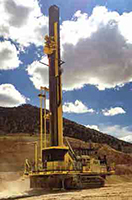
Feedback from that North American customer led to some updates to software and automation systems. For example, Komatsu updated the logic for the auto-drilling software. “The result was a day-and-night improvement over the old system,” Li said. “We have been seeing very good collars compared to what we had before the change.” Other innovation include a boxer- style mast that “is completely different from the traditional lattice-style masts that most competitor drills use,” he said. “We have also created a new rack-and-pinion pulldown system that increases the reliability and at the same time the precision.”
It also reduces the downtime required for maintenance. “Operations can benefit from the 77XR and future drills that we will be launching with these features.” For example, the automated bit changer, which is optional on the 77XR, offers substantial safety and efficiency improvements. “This is a huge upgrade,” he said. “This system reduces the downtime from an hour on average to change a tricone bit to about five to 10 minutes.” It also “takes the operator and maintenance personnel out of the line of fire because it will not require people to be working on the drill deck to change a tricone bit,” Li said. “Instead of that, everything is done through the operator’s cabin by the operator pressing buttons.”
Komatsu also reported that tracking stats show the 320XPC offers availability of as high as 90% in some of the most extreme mining environments on the planet. “Especially in Latin America, with those mines that are at a really high-altitude and also in extremely hard rock iron ore mines in the U.S. or in the Canadian Iron Range where we see temperatures of -50°F,” Li said.
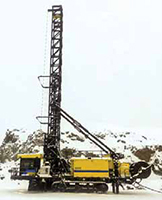
After two years of development at Australian mines, “we’ve entered the market with the ZT44, which is like the track drill that spends all summer in the weight room,” said Matt Koss, product manager, track drills, Komatsu. “It is just a big, sturdy, powerful machine,” he said. “For comparison, it is an around 85,000-lb machine compared to other machines in this class that weigh in at around 55,000 to 60,000 lb.” It is ideal for customers in need of a mining-class track drill for auxiliary work and to go where platform drills can’t go. “From a market perspective, it is a production-type machine,” Koss said. “It is also going to have the agility those track drills have,” he said. “It kind of offers the best of both worlds.”
The unit proved its capabilities at a hard rock operation in the U.S. last summer when it was pitted against a similar competitor. The ZT44 had a smaller footprint but a bigger engine and compressor, so it prevailed. “Logically, it has more potential to drill quicker,” Koss said. It’s ability hole to hole also helped deliver superior production. “The benches were at times a little tricky to get around,” Koss said. “Our machine is built robust and stout where it can keep the mast up in the air and go to the next hole and start drilling,” he said. “When you looked at what you were drilling, total production per hour, we had 15% to 20% advantage just in that respect.”
It is ideal for up to 8-in. holes, he said. “The machine excels at that.” The dual pressure-controlled air compressor offers 500 psi. “Or you can flex it to 350 psi depending on rock hardness,” Koss said. “The next closest in its class is around 420 psi.” The engine has 800 hp. “The next closest would be about 540 hp,” he said. It is built for production in harsh conditions. “We have a heat exchange unit on this that is different from any other,” Koss said. “This machine has an engineered life of up to 40,000 hours,” he said. “With tough applications, really harsh climates, it fits right in.”
And compared to the other rigs in its class, it is a brute. “The machine is unique,” he said. “It is on the high end of the track drill market, but it also operates in the same class as the small platform machines.” Which means it is peerless. “Right now, it is giving customers an option that doesn’t otherwise exist,” Koss said. “No one operates in that space.” At MINExpo, Komatsu will launch a new blasthole drill based on the 77XR, but upgraded, bigger, and capable of up to 13.75-in. holes.

A Fully Integrated Approach
Caterpillar reported major updates to
four machines were designed to dramatically
increase drilling performance. In
a report for E&MJ, Cat said the results
of the upgrades will not just help drill
operators best personal records, but will
aid downstream operations and add value
overall to the mine.
“Caterpillar focused on increasing
reliability, serviceability, performance,
and technology when reengineering its
drill family with a fully integrated approach,”
Caterpillar reported.
“The line includes common parts
and components, technologies plus systems
integrations across the Cat drills
product line,” Cat said. “In addition,
updates to machine design based on
a common platform across all models
streamlines operator training, maintenance
strategies and planning.”
The major updates included design improvements to the powertrains, further integration of Cat electronics, a next-generation cab, more capability to adopt next-level technology and automation, and improved serviceability and support. The updates were first launched in the MD6250, MD6310, MD6200 and MD6380. Caterpillar implemented design improvements to the powertrains that target full system optimization, an application specialist said. “For drills, the focus has to be on the larger systems,” said Greg Scott, a rotary blasthole drill expert at Cat. The powertrain system includes the engine, compressor, hydraulics and undercarriage.
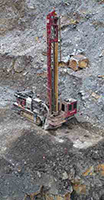
Similarly, Cat electronics, both hardware and software, were fully synced. Common parts to the four drill rigs now include electronic control modules, sensors, switches, touchscreens, and wiring harnesses. “Caterpillar computer controls bring the machine together with over 50 integrated protection features to avoid costly failure and downtime, plus automated key functions on the drill to drive toward higher production that’s repeatable,” Cat reported. “Controls like Caterpillar’s new electronic compressor regulation help boost productivity while reducing fuel burn,” Caterpillar said. “The new compressor controls modulate working pressure and air volume flow, matching the drill’s compressed air output to the specific application, based on the tooling used and how it interacts with ground conditions.”
The controls fine tune hydraulic performance so individual functions are smooth and efficient. “Precision control feeds into auto-functionality, such as Drill Assist auto-drill that adapts both feed force and rate to rotary head rpm and torque,” Caterpillar said. “These units work in concert, so the right amount of pulldown and rotary torque are provided based on bit advance per revolution to ensure the machine delivers optimal power to the cutting tool for maximum productivity with longest tool service life.” Upgrades to the cab will be noticeable to operators and should contribute to improved job satisfaction. The cabs are different on each machine, but offer the same general layout. “The next-generation cabs are designed to promote safety, comfort, and productivity,” Caterpillar said.
“Visibility has been improved with extended windows and a video system consisting of three to four cameras around the perimeter of the drill, depending on the model,” the company reported. “A separate mast camera allows the operator to see the pipe rack carousel during pipe-change operations.” The upgrades include more technology building blocks to ensure the machines can adopt new automation solutions as they are released. “Scalable technologies available for Cat drills serve as building blocks to meet the level of automation needed at the mine site,” Caterpillar reported. “Drill Assist functions, Cat Terrain for drilling with high precision GPS positioning, semi-autonomous or autonomous features, plus machine health reporting help to improve drilling efficiencies and results.”
For single-pass drilling, Drill Assist can perform every step of the drill cycle and adjust drill power to match ground conditions. “Other features include auto level and auto jack retreat, auto mast raise-and-lock and unlock-and-lower, and auto pipe-handling has been developed for multi-pass auto drill to depth,” Caterpillar reported. The automation solution Terrain, a Cat MineStar system, uses GPS guidance to make sure holes are drilled according to plan, in the right place and to the right depth. “This technology improves pattern accuracy and reduces over- and under-drilling, leading to lower costs and faster, smoother operation,” Cat said.
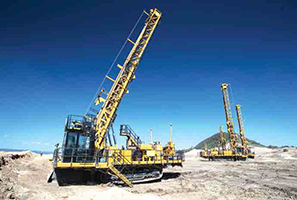
Filling an Industry Gap
EuroforGroup reported seeing growing
demand for the reliable and versatile
RTD55, the most popular of the 20-
rig RTDrill range. “The RTD55 is an
extremely powerful and robust drilland-
blast drill rig,” said Mani Pessiani,
international sales director, RTDrill.
“When the rig is compared side-by-side
in the field to similar drill rigs, it beats
all the competitors in machine uptime
and speed of meters drilled per hour.”
The 3.1-m-wide, 36,000-kg rig is
made in the U.S. “using premium-quality
components that make this machine
easy to maintain and provide incomparable
longevity,” he said. “The high
productivity is provided through the kinematics of the RTD55, making it agile
in its movements and by the speed feed
of the regen system.”
It “is suitable for rotary and DTH multi-pass, with 9.1-m drill pipes in a carousel that can hold up to 6+1,” Pessiani said. Configured for DTH, it can drill a 172-mm hole with a depth of up to 60 m. “And it can also drill hole sizes up to 229 mm in full rotary mode with a dual motor system rotary head.” The rotary head is capable of 7,300 Nm torque. It offers a maximum single-pass depth of up to 9 m. The rig comes with either a (Tier-III or -IV) Cat C15 or a Cummins QSX 15 (up to 433-kW) engine with a low- or high-pressure (8.6- or 25.5-Bar) compressor that delivers up to 31.1-m3/min. “It has very efficient engine-compressor settings and controls that give low fuel consumption and optimizes the production costs,” Pessiani said.
It has a two-man air-conditioned cab with electric-hydraulic controls. The cab is falling-object protection certified at ISO 3449. A drill pipe thread grease system, a feed-interrupt switch, and pushbutton E-Stop shutdown come standard. “The number of electronic components and sensors are limited, so the usage of the machine is not too much affected in case of failure of one of them, and this keeps high the availability of the RTD55,” Pessiani said. Optional is a high-standard multicore cooler package with thermostatic controlled fan, a custom drilling package, and dust control systems. “Many options are available to customize the machine so it fits all the needs of the user, such as drilling monitoring and drilling assistance features,” he said. “This gives the possibility that the RTD55 can be used in an autonomous mode from a command center.”
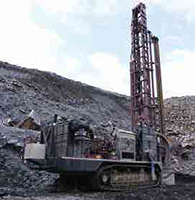
The DTH and rotary rigs offered by both suppliers were consolidated under the RTDrill brand in 2020. “With a wide range of products and an extensive worldwide distribution network, and with two factories and a unified design office, the RTDrill rigs are being constantly adjusted to the customer needs by integrating all the necessary specifications and enhancements for better productivity and efficiency,” Pessiani said. The brand launch propelled EuroforGroup into the ranks of global drill rig OEMs. The company had been in the drilling business since 1972 as a specialist distributer in Europe and Africa. “Our desire to become a worldwide drill-and-blast OEM was to fill an industry gap in quality services,” he said.
“Our team today is working hard to set up and support our independent distributers around the world to provide the best services to mining companies and contractors in these difficult times,” Pessiani said. “We are innovating in the designs of our machines by bringing products to the market that are giving efficient alternative solutions.” RTDrill will be at MINExpo in the North Hall in booth 1738.